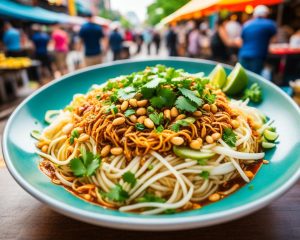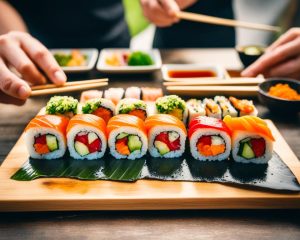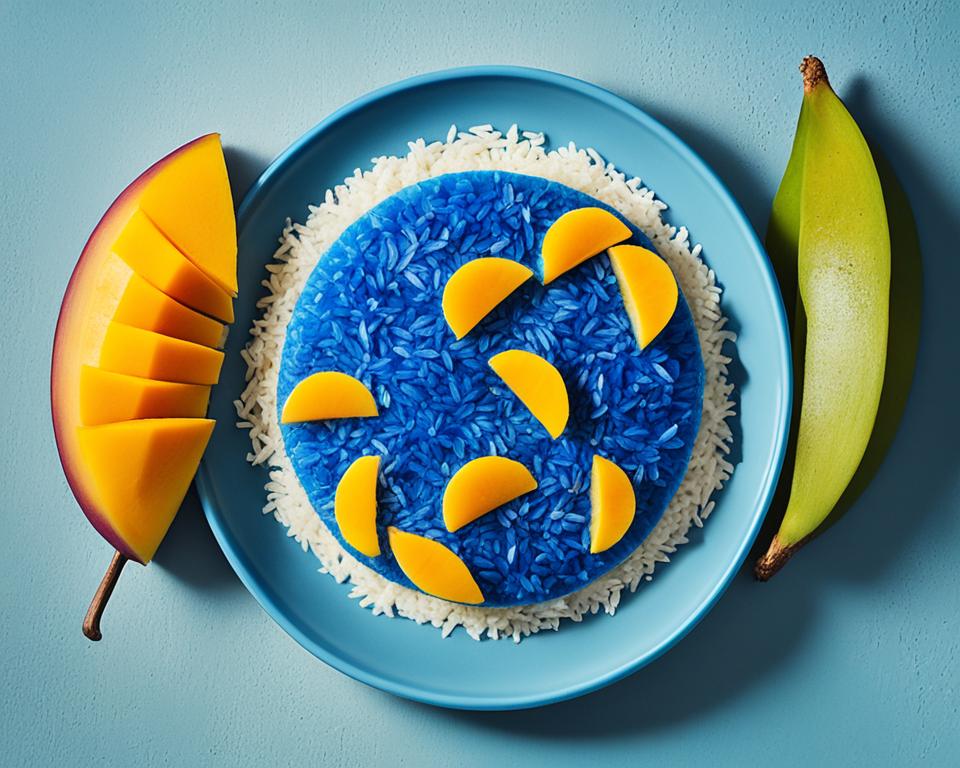
Indulge your taste buds with the vibrant flavors of blue mango sticky rice, a delightful Thai dessert that is both gluten-free and vegan. In this article, we will explore the beauty and deliciousness of this visually stunning treat.
What is Blue Mango Sticky Rice?
Blue mango sticky rice is a traditional Thai dessert that combines the rich flavors of coconut milk and sweet mango with the unique twist of vibrant blue sticky rice. This visually stunning dessert is a feast for the eyes and the taste buds, making it a favorite among locals and tourists alike.
The key ingredient in blue mango sticky rice is, of course, the blue sticky rice. This glutinous rice gets its striking blue hue from the natural extract of butterfly pea flowers. The rice is soaked overnight and then steamed until perfectly tender and sticky.
Another essential component of this dessert is fresh ripe mango. The sweet and juicy mango complements the creamy coconut milk and adds a burst of fruity flavor to every bite. The combination of mango, coconut milk, and blue sticky rice creates a delightful harmony of textures and tastes.
Read more interesting information at ::102aoki
The Traditional Preparation Method
The traditional preparation of blue mango sticky rice involves cooking the blue sticky rice in coconut milk, which infuses it with a rich and indulgent flavor. The rice is then sweetened with sugar and salt to achieve the perfect balance of sweetness and depth.
Once the rice is cooked and seasoned, it is served alongside slices of ripe mango and a drizzle of coconut milk. The final touch is a sprinkle of toasted sesame seeds for added crunch and nuttiness.
“Blue mango sticky rice is a beloved Thai dessert that showcases the country’s unique culinary traditions and the harmonious blend of flavors.”
This traditional dessert is not only a delicious treat but also a representation of Thai culture and heritage. The combination of coconut milk, mango, and blue sticky rice reflects the country’s reliance on these ingredients in its cuisine.
Coconut milk, in particular, is a staple in Thai cooking and plays a significant role in many dishes, both savory and sweet. Its rich and creamy texture adds depth and complexity to the flavors of blue mango sticky rice.
Whether enjoyed as a sweet ending to a Thai feast or as a standalone indulgence, blue mango sticky rice is a delightful dessert that celebrates the unique flavors and traditions of Thailand.
| Ingredients | Quantity |
|---|---|
| Blue glutinous rice | 1 cup |
| Water | 2 cups |
| Coconut milk | 1 cup |
| Sugar | 1/2 cup |
| Salt | 1/4 teaspoon |
| Ripe mango | 1, sliced |
| Toasted sesame seeds | For garnish |
The Significance of Blue Mango Sticky Rice in Thai Cuisine
Blue mango sticky rice holds a special place in Thai cuisine, embodying the rich cultural heritage and culinary traditions of Thailand. This delightful dessert, beloved by both locals and tourists, showcases the artistry and flavors that define the country’s gastronomy.
In Thai culinary culture, desserts hold great importance as they bring balance and harmony to meals. Blue mango sticky rice, known as “Khao Niao Mamuang” in Thai, exemplifies the perfect blend of textures and flavors that Thai desserts are cherished for.
Mangoes are one of the most iconic fruits in Thailand, and they symbolize abundance, happiness, and good fortune. When combined with the sticky rice, the dish takes on a lusciously sweet and creamy taste. The addition of blue coloring adds a touch of visual appeal, making the dessert even more enticing.
Blue mango sticky rice is not only enjoyed as a dessert but is also a significant part of festive occasions and celebrations in Thailand. It is often served during special events like Songkran, the Thai New Year, and Loy Krathong, the Festival of Lights. The vibrant blue color catches the eye and uplifts the spirit, creating a memorable experience for all who indulge in this traditional treat.
This traditional Thai dessert is a testament to the creativity and innovation of Thai cuisine. The combination of sweet sticky rice, succulent mangoes, and aromatic coconut milk reflects the harmony in Thai flavors. The use of traditional ingredients and cooking methods ensures that each mouthful is a delightful journey into the heart of Thai gastronomy.
The Festive Charm of Blue Mango Sticky Rice
Blue mango sticky rice holds a special significance during Thai festivals and celebrations. Its vibrant blue color and exotic flavors make it a must-have delicacy during these joyous occasions. It represents the spirit of togetherness, symbolizing the shared experiences and cultural traditions of the Thai people.
Furthermore, blue mango sticky rice has become an iconic dessert that reflects Thai identity and heritage. It has gained popularity not only in Thailand but also internationally, captivating the taste buds of food enthusiasts worldwide. Its unique combination of colors, textures, and flavors has made it a dessert trendsetter, inspiring chefs and home cooks alike.
Next, we will delve into the visual presentation of blue mango sticky rice, exploring how its vibrant colors and tantalizing aesthetics contribute to the overall culinary experience.
The Appeal of Visual Presentation
One of the most enticing aspects of blue mango sticky rice is its visually stunning presentation. This vibrant dessert captivates the eyes with its beautiful blue hue and contrasting textures. The mesmerizing color of blue mango sticky rice adds an element of intrigue and uniqueness to the dining experience, making it a feast for both the eyes and the taste buds.
The vibrant blue color of the dish is derived from the use of butterfly pea flower extract, which imparts a natural blue tint to the sticky rice. This brilliant shade stands out on the plate, creating a visually striking arrangement that instantly grabs attention.
Additionally, the presentation of blue mango sticky rice often involves arranging fresh slices of ripe mango on top of the rice bed. The vibrant yellow-orange hues of the mango complement the blue backdrop, creating a visually pleasing color contrast. The combination of the blue rice and the yellow-orange fruit creates a visually appealing masterpiece that is just as delightful to look at as it is to indulge in.
Moreover, the textural contrast between the sticky rice and the juicy mango slices adds another dimension to the visual presentation. The soft and sticky texture of the rice is balanced by the juicy and refreshing texture of the mango, creating a harmonious marriage of flavors and mouthfeel.
The visual appeal of blue mango sticky rice is not only a testament to its aesthetic beauty but also to the vibrant flavors that await those who taste it.
To enhance the presentation of blue mango sticky rice further, some chefs may garnish the dish with mint leaves or sprinkle toasted sesame seeds on top. These additional touches not only contribute to the visual appeal but also add subtle flavors and textures.
When served in a coconut shell or a traditional Thai dessert boat, the visual impact is elevated even further. The natural colors and textures of the vessel enhance the overall presentation, making it even more enticing and representative of the rich Thai culinary heritage.
In conclusion, the visually stunning presentation of blue mango sticky rice not only adds to the allure of this sweet treat but also provides a feast for the eyes. The vibrant blue color, the contrasting textures, and the thoughtful arrangement make it an irresistible dessert that combines visual appeal with vibrant flavors.
How to Make Blue Mango Sticky Rice at Home
Creating your own blue mango sticky rice at home is easier than you might think! With just a few simple steps, you can enjoy this delightful Thai dessert in the comfort of your own kitchen. Follow our recipe below to impress friends and family with your homemade treat.
Gather Your Ingredients
Before diving into the cooking process, make sure you have all the necessary ingredients on hand:
- 1 cup of sticky rice
- 1 cup of blue pea flower water
- 1 cup of coconut milk
- 1/2 cup of sugar
- 1/4 teaspoon of salt
- Fresh mango slices for serving
Note: Blue pea flower water can be made by soaking dried blue pea flowers in warm water and straining out the petals.
Cook Your Sticky Rice
Start by rinsing your sticky rice under cold water until the water runs clear. Soak the rice in water for at least 4 hours or overnight. Once soaked, drain the rice and place it in a steamer lined with cheesecloth or a banana leaf. Steam the rice for approximately 25-30 minutes, or until it is tender and has a slightly chewy texture.
Prepare the Blue Mango Sauce
While the sticky rice is steaming, prepare the blue mango sauce by combining the blue pea flower water, coconut milk, sugar, and salt in a saucepan. Cook over low heat, stirring occasionally, until the sugar has dissolved and the mixture is well combined. Remove from heat and let the sauce cool.
Assemble and Serve
Once the sticky rice is cooked, transfer it to a bowl and pour the blue mango sauce over the top. Gently mix the rice and sauce together until the rice is evenly coated. Allow the rice to cool slightly before serving.
To serve, place a portion of the blue mango sticky rice on a plate and top it with fresh mango slices. The vibrant colors of the rice and mango will create a visually stunning dessert that is sure to impress.
Enjoy your homemade blue mango sticky rice as a sweet and satisfying treat. The combination of the tender sticky rice, rich coconut milk, and sweet mango will transport your taste buds to Thailand.
Ingredients for Blue Mango Sticky Rice
When it comes to making blue mango sticky rice, the right ingredients can make all the difference. Not only is this dessert visually stunning, but it’s also gluten-free and vegan-friendly, making it a delightful treat for people with dietary restrictions. Let’s take a look at the key components that bring this dish to life.
Mangoes
Mangoes are the star of the show in blue mango sticky rice. Choose ripe and juicy mangoes for the best flavor. Their sweetness pairs perfectly with the creamy texture of the rice and adds a burst of tropical freshness to each bite.
Sticky Rice
Sticky rice, also known as glutinous rice, is the base of this delightful dessert. This short-grain rice has a sticky texture when cooked, perfect for absorbing the flavors of the coconut milk and mango. Look for Thai sweet rice or sticky rice at your local Asian grocery store.
Coconut Milk
Coconut milk is essential for creating the rich and creamy sauce that envelopes the sticky rice. Opt for full-fat coconut milk to achieve a luscious texture and full-bodied flavor. For a lighter version, you can use light coconut milk, but keep in mind that the result might be slightly less indulgent.
Blue Butterfly Pea Flowers
What gives blue mango sticky rice its vibrant blue hue? The secret is blue butterfly pea flowers. These natural colorants infuse the rice with a striking blue color, adding a visually captivating element to the dish. You can find dried blue butterfly pea flowers online or at specialty herb stores.
Sugar
To balance the flavors and enhance the sweetness, a touch of sugar is added to the sticky rice. White or brown sugar can be used, depending on your preference. Adjust the amount of sugar according to your taste.
Salt
A pinch of salt is essential for balancing the sweetness and bringing out the flavors of the other ingredients. Don’t skip this small but crucial addition that elevates the overall taste profile of the dessert.
“The right combination of mangoes, sticky rice, coconut milk, and a touch of sweetness creates a harmonious blend of flavors and textures in blue mango sticky rice.”
These are the essential ingredients you’ll need to create a delicious batch of blue mango sticky rice. Feel free to experiment with other additions or substitutions to suit your preferences. Now that we’ve covered the ingredients, let’s move on to the cooking process and the step-by-step recipe.
Cooking Blue Mango Sticky Rice
Now that you have all the ingredients ready, it’s time to dive into the cooking process of blue mango sticky rice. Follow these detailed instructions to create a delectable dish that showcases the vibrant flavors of blue mango sticky rice.
Soaking the Rice
Start by rinsing 1 cup of sticky rice in cold water until the water runs clear. Then, place the rice in a bowl and cover it with water. Allow the rice to soak for at least 4 hours or overnight.
Preparing the Steamer
While the rice is soaking, prepare a steamer by filling a pot halfway with water. Place the steamer basket on top and bring the water to a simmer over medium heat.
Steaming the Rice
Once the rice has soaked, drain it and transfer it to a shallow heatproof dish or a bamboo steamer lined with cheesecloth. Spread the rice evenly in the dish or steamer, ensuring it is not crowded.
Place the dish or steamer on top of the pot with simmering water, ensuring that it doesn’t touch the water. Cover the dish or steamer with a lid or aluminum foil to trap the steam.
Steam the rice for about 25-30 minutes, or until it becomes tender and slightly translucent. Stir the rice occasionally to ensure even cooking.
Infusing Coconut Milk Flavor
While the rice is steaming, it’s time to infuse the flavors of coconut milk. In a saucepan, combine 1/2 cup of coconut milk, 1/4 cup of sugar, and a pinch of salt. Heat the mixture over medium heat, stirring occasionally until the sugar has dissolved.
Coating the Rice
Once the rice is cooked, transfer it to a large bowl and pour the warm coconut milk mixture over it. Gently fold the rice and coconut milk together, ensuring that each grain is coated with the flavorful liquid.
Cover the bowl and let the rice soak in the coconut milk for at least 15 minutes, allowing it to absorb the flavors and become even more luscious.
Serving the Blue Mango Sticky Rice
Now that your blue mango sticky rice is ready, it’s time to serve and enjoy this delightful Thai dessert. Spoon the rice onto serving plates or bowls and top it with fresh ripe mango slices. You can also drizzle some additional coconut milk over the rice for extra creaminess.
The combination of the sweet and aromatic blue mango sticky rice with the juicy mangoes creates a harmonious blend of flavors. The vibrant blue color of the rice, accompanied by the vibrant yellow of the mangoes, makes for a visually stunning dessert that is sure to impress.
With its unique combination of flavors and colors, blue mango sticky rice is a true culinary delight that encapsulates the essence of Thai cuisine. Indulge in this delicious treat and savor the cultural experience it brings to your taste buds.
The Blue Mango Sauce
When it comes to enjoying a vibrant and delicious bowl of blue mango sticky rice, one crucial element that elevates the flavor profile is the blue mango sauce. This homemade sauce adds a touch of sweetness and enhances the overall taste of the dish, making it a truly delightful sweet treat.
Made with the finest blue mangoes and a few simple ingredients, this sauce perfectly complements the sticky rice, creating a harmonious blend of flavors. The homemade blue mango sauce adds an extra layer of richness and indulgence to the dish, making every bite a memorable experience.
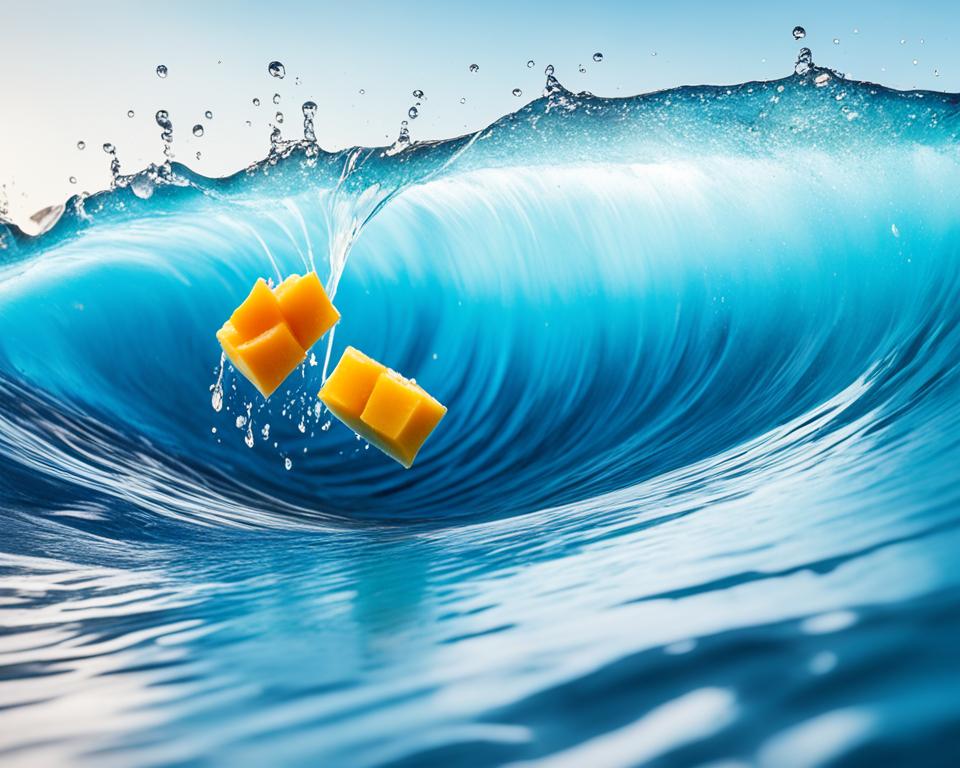
Using fresh blue mangoes is essential for creating the most flavorful sauce. Their exotic sweetness and vibrant color infuse the sauce with a distinct tropical essence. To make the blue mango sauce, simply puree the ripe blue mangoes until smooth, and then add a dash of honey or sugar to enhance the sweetness to your liking.
This sauce can be prepared in advance and stored in the refrigerator until ready to serve. Its cooling and refreshing qualities make it a perfect accompaniment to the warm and luscious blue mango sticky rice. Whether you drizzle it over the sticky rice or serve it on the side, the blue mango sauce adds a burst of fruity goodness to each mouthful.
Serving and Presentation
When it comes to blue mango sticky rice, presentation is key. The vibrant blue color of this delightful dessert calls for visually appealing serving suggestions and garnishes that enhance its sweet treat allure. Let’s explore some creative ways to present blue mango sticky rice and make it an absolute feast for the eyes.
To start, consider using a pristine white plate or bowl as the canvas for your dish. The contrast between the blue rice and the white background will make the colors pop. Alternatively, you can opt for a stylish black plate that adds a touch of sophistication to the presentation. Remember, the goal is to accentuate the visual appeal of the dish.
Next, arrange the blue mango sticky rice neatly in a mound at the center of the plate. The texture and shape of the rice create an interesting visual element. You can use a ring mold or even a spoon to shape the rice into a perfect circle for a more polished appearance.
To further elevate the presentation, don’t shy away from adding garnishes that complement the sweet treat. Thin slices of ripe mango, fresh mint leaves, and a sprinkle of toasted coconut flakes are fantastic choices. These garnishes not only enhance the visual appeal but also add layers of flavor and texture to each bite.
| Garnish Ideas for Blue Mango Sticky Rice |
|---|
| Ripe Mango Slices: These juicy and golden mango slices add a burst of color and a delightful tropical flavor. |
| Fresh Mint Leaves: The vibrant green hue of mint leaves adds a beautiful contrast against the blue rice, while also providing a refreshing aroma. |
| Toasted Coconut Flakes: Toasted coconut flakes not only bring a subtle nutty flavor but also provide a satisfying crunch to each spoonful of blue mango sticky rice. |
Remember to arrange the garnishes in an aesthetically pleasing way, scattering them around the rice or gently placing them on top. A little bit of careful arrangement can go a long way in creating an impressive visual presentation.
Additionally, consider drizzling a homemade blue mango sauce over the rice, highlighting the dreamy blue color and adding a touch of sweetness. The sauce will not only enhance the overall presentation but also intensify the flavor profile of the dish.
With these serving and presentation ideas, you’ll be able to showcase the beauty of blue mango sticky rice and turn it into a visual masterpiece. Remember, the visual presentation of a sweet treat is just as important as its taste, making your dining experience truly memorable.
Health Benefits of Blue Mango Sticky Rice
Blue mango sticky rice not only satisfies your taste buds with its vibrant flavors but also offers several health benefits. This gluten-free and vegan dessert contains key ingredients that contribute to its nutritional value.
One of the main ingredients in blue mango sticky rice is coconut milk, which provides numerous health benefits. Coconut milk is a rich source of healthy fats and medium-chain triglycerides (MCTs), which are easily digested and converted into energy by the body. MCTs have been linked to improved digestion, increased metabolism, and weight management.
Additionally, coconut milk is known for its high content of essential minerals such as manganese, copper, iron, and magnesium. These minerals play crucial roles in supporting bone health, promoting a strong immune system, and aiding in the formation of red blood cells.
The use of mango in blue mango sticky rice adds another layer of nutritional benefits. Mangoes are loaded with vitamins, particularly vitamin C and vitamin A. Vitamin C is essential for strengthening the immune system and promoting collagen production for healthy skin. Vitamin A contributes to eye health, supports cell growth and differentiation, and acts as a powerful antioxidant.
Being gluten-free, blue mango sticky rice is an excellent dessert option for individuals with gluten sensitivities or celiac disease. It allows everyone to savor the sweet delight without worrying about any adverse effects.
| Health Benefits of Blue Mango Sticky Rice | Keywords |
|---|---|
| Rich in healthy fats and MCTs | coconut milk |
| High in essential minerals | coconut milk |
| Abundant in vitamins C and A | mango |
| Gluten-free option | gluten-free |
The Nutritional Value of Coconut Milk
Coconut milk is not only a delicious ingredient but also a great source of essential nutrients. Here is a breakdown of the nutritional content found in coconut milk:
- Healthy fats: Coconut milk contains approximately 57 grams of fats per cup, with the majority of these being saturated fats. While saturated fats have been previously associated with negative health effects, recent studies suggest that the medium-chain triglycerides (MCTs) found in coconut milk may have potential health benefits.
- Vitamins: Coconut milk is a good source of vitamins such as vitamin C, vitamin E, and various B vitamins, including folate, niacin, and thiamin.
- Minerals: Coconut milk provides essential minerals like iron, magnesium, potassium, and zinc.
- Dietary fiber: A cup of coconut milk contains 10 grams of dietary fiber, which aids in digestion and promotes a healthy gut.
While coconut milk does contain calories and fats, it can still be a part of a balanced diet when consumed in moderation. Remember to consider your overall calorie and nutrient intake when incorporating coconut milk into your meals and desserts.
Variations and Additions
Blue mango sticky rice is a versatile dish that can be customized with various variations and additions to suit different taste preferences. By incorporating different fruits and spices, you can elevate the flavors and create a unique twist on this traditional Thai dessert.
Fruit Variations
One delicious variation of blue mango sticky rice is to replace the mango with other tropical fruits. Consider using ripe pineapple, juicy papaya, or sweet bananas as alternatives. These fruits will bring their own distinct flavors and textures, adding a fresh and vibrant element to the dish. You can also mix and match different fruits to create a colorful and visually appealing presentation.
Spice Infusions
To add depth and complexity to the flavor profile of blue mango sticky rice, you can experiment with spice infusions. Try infusing the coconut milk with warm spices like cinnamon, cardamom, or vanilla for a fragrant twist. Alternatively, you can incorporate a hint of heat with a pinch of chili powder or a drizzle of chili-infused oil. These spice variations will add a unique twist to the dish and elevate its overall taste.
Coconut Milk Substitutes
While coconut milk is a traditional component of blue mango sticky rice, you can also explore alternative options based on dietary restrictions or personal preference. Consider using almond milk, soy milk, or cashew milk as substitutes for coconut milk. These alternatives will impart their own subtle flavors and textures, offering a different take on the recipe while maintaining the essence of the dish.
Tip: When experimenting with variations and additions to blue mango sticky rice, remember to maintain a balance between the key ingredients and the new elements. The variations should complement the flavors of the dish rather than overpower them.
By exploring different fruit variations, spice infusions, and coconut milk substitutes, you can create exciting and personalized renditions of blue mango sticky rice. Whether you prefer a tropical fruit medley, a spiced infusion, or a unique milk substitute, these variations will add depth and individuality to this beloved Thai dessert.
Blue Mango Sticky Rice Around the World
Blue mango sticky rice has gained significant global popularity as a beloved Thai dessert. This visually stunning dish has captivated food enthusiasts worldwide with its vibrant blue hue and delightful flavors.
Thai desserts, known for their unique taste and presentation, have become increasingly popular in international cuisine. Blue mango sticky rice, with its distinctive color and traditional roots, has emerged as a standout dessert that showcases the rich culinary heritage of Thailand.
While it originated in Thailand, blue mango sticky rice can now be found in various parts of the world. The global popularity of this dessert can be attributed to its exquisite visual appeal and the fusion of authentic Thai flavors with local ingredients and influences.
Restaurants and food establishments around the world have embraced blue mango sticky rice, incorporating it into their menus to cater to the growing demand for this delectable treat. Food bloggers and social media influencers have also played a crucial role in spreading awareness about this vibrant dessert, further amplifying its global reach.
The international popularity of blue mango sticky rice not only reflects the increasing appreciation for Thai cuisine but also highlights the universal love for visually appealing and delicious desserts. Its unique combination of colors, textures, and flavors makes it an enticing sweet treat for food lovers of all backgrounds.
| Country | Popularization |
|---|---|
| United States | Thai restaurants and food trucks have introduced blue mango sticky rice to American food enthusiasts, increasing its popularity in major cities like Los Angeles, New York, and San Francisco. |
| United Kingdom | Thai cuisine has gained significant traction in the UK, and blue mango sticky rice has become a sought-after dessert in London and other metropolitan areas. |
| Australia | With its multicultural food scene, Australia has warmly embraced blue mango sticky rice, featuring it on menus in cities like Sydney, Melbourne, and Brisbane. |
| Japan | Blue mango sticky rice has been incorporated into the Japanese dessert culture, with restaurants and cafes in Tokyo and other cities offering their unique interpretations. |
| Singapore | Singapore’s diverse culinary landscape has welcomed blue mango sticky rice, making it popular in hawker centers and upscale dining establishments. |
Experience the Global Delight of Blue Mango Sticky Rice
Whether you’re in Thailand or exploring international cuisines, blue mango sticky rice is a dessert worth trying. Its global popularity is a testament to its exceptional appeal and the joy it brings to food lovers worldwide. Indulge in the vibrant colors and flavors of this Thai delight, and let your taste buds embark on a delightful journey.
Blue Mango Sticky Rice as a Dessert Trend
Over the past few years, blue mango sticky rice has gained popularity as a delightful sweet treat and a dessert trend in the culinary world. This vibrant dish has captivated dessert lovers with its stunning visuals and unique flavor combination.
Blue mango sticky rice stands out from traditional desserts due to its visually appealing blue hue, which is achieved by using natural food colorings such as butterfly pea flower or blue spirulina. The blue color adds an element of surprise and excitement to the dessert, making it an Instagram-worthy treat that is sure to impress.
Aside from its striking appearance, blue mango sticky rice offers a harmonious blend of textures and flavors. The sticky rice, cooked to perfection, offers a chewy and comforting base, while the sweet mango provides a juicy and refreshing contrast. The creamy coconut milk ties all the elements together, infusing the dessert with rich coconut flavor.
“Blue mango sticky rice is not just a delicious dessert, but also a feast for the eyes. Its visually stunning presentation and mouthwatering flavors make it a true showstopper.”
This dessert trend has quickly taken hold in various culinary scenes, captivating food enthusiasts around the world. Whether it’s served at high-end restaurants or local food stalls, blue mango sticky rice has become a sought-after dessert for those looking to indulge in something both visually striking and deliciously satisfying.
Thanks to its gluten-free and vegan nature, blue mango sticky rice has also gained popularity among those with dietary restrictions. It offers a guilt-free option for individuals seeking a delectable dessert that can be enjoyed by all.
Blue Mango Sticky Rice: A Dessert Trend to Try
If you haven’t had the chance to experience the wonders of blue mango sticky rice yet, it’s time to give it a try. Whether you’re a fan of Thai cuisine or simply enjoy exploring new dessert trends, this sweet treat is sure to leave a lasting impression.
With its striking visuals, vibrant flavors, and unique blend of textures, blue mango sticky rice is a dessert that satisfies both the eyes and the taste buds. Its popularity as a dessert trend is no surprise, considering its undeniable charm and unforgettable taste.
Next time you find yourself craving a sweet indulgence, consider embracing the blue mango sticky rice trend and treat yourself to an extraordinary dessert experience.
Other Colorful Desserts to Explore
While blue mango sticky rice is undoubtedly a vibrant and visually stunning Thai dessert, there are many other colorful desserts within Thai cuisine that are worth exploring. These desserts not only satisfy the sweet-tooth cravings but also provide a feast for the eyes. Let’s take a look at some delightful options that will surely bring a burst of color to your table.
1. Rainbow Sticky Rice
Rainbow sticky rice is a playful and colorful twist on the traditional Thai dessert. Made with different colors of glutinous rice and infused with natural food coloring, this dessert is as visually appealing as it is delicious. Each layer of sticky rice offers a unique flavor, making every bite a delightful surprise.
2. Water Chestnut Rubies
Water chestnut rubies, also known as tub tim krob, is a refreshing and vibrant Thai dessert. The dessert consists of bite-sized water chestnut pieces coated in colored tapioca flour, representing rubies, and served in a sweet coconut milk syrup. The contrasting textures and colors create a visually stunning dessert that is both sweet and satisfying.
3. Mango Sticky Rice
Another popular Thai dessert, mango sticky rice, is a delightful combination of fresh ripe mangoes, sticky glutinous rice, and coconut milk. The vibrant yellow mangoes paired with the white rice make for a visually pleasing treat. The creamy sweetness of the coconut milk ties all the flavors together for a truly tropical dessert experience.
4. Thai Tea Tiramisu
A unique twist on the classic Italian dessert, Thai tea tiramisu combines the rich flavors of Thai tea with the creamy goodness of mascarpone cheese. This dessert features layers of soaked ladyfingers, Thai tea-infused cream, and a dusting of cocoa powder. The combination of earthy orange hues with the velvety texture creates a dessert that is both visually striking and a delight to savor.
These colorful desserts not only showcase the creativity and artistry of Thai cuisine but also demonstrate how ingredients can be transformed into visually stunning masterpieces. Whether you’re a fan of traditional Thai desserts or looking for a vibrant twist on familiar flavors, these desserts are sure to leave a lasting impression on your taste buds and captivate your senses.
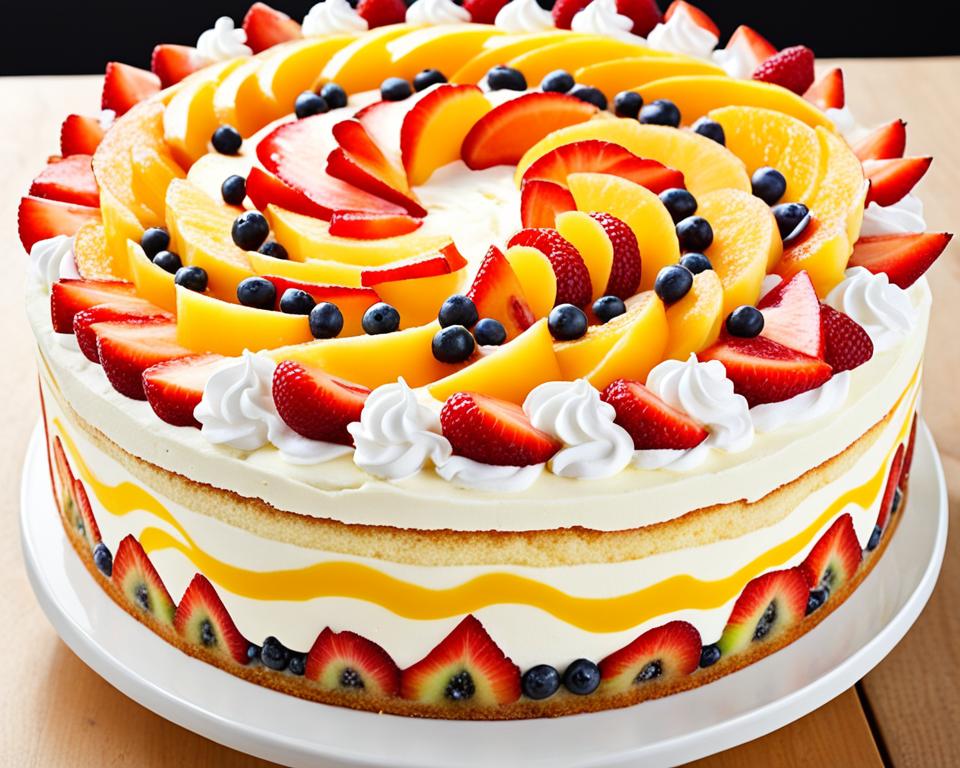
Conclusion
In conclusion, blue mango sticky rice is a vibrant and delicious twist on the traditional Thai dessert. With its visually stunning blue color and mouthwatering flavors, it has become a popular sweet treat both in Thailand and around the world.
The dish’s traditional preparation, using homemade coconut milk, adds to its authenticity and gives it a creamy and aromatic taste. Its gluten-free and vegan attributes make it a versatile choice for those with dietary restrictions.
Whether enjoyed during festivals and celebrations or as a delightful homemade dessert, blue mango sticky rice is a true delight for the senses. I encourage you to explore this traditional Thai dessert, try it out at home, and indulge in the unique flavors and visual presentation it has to offer.
